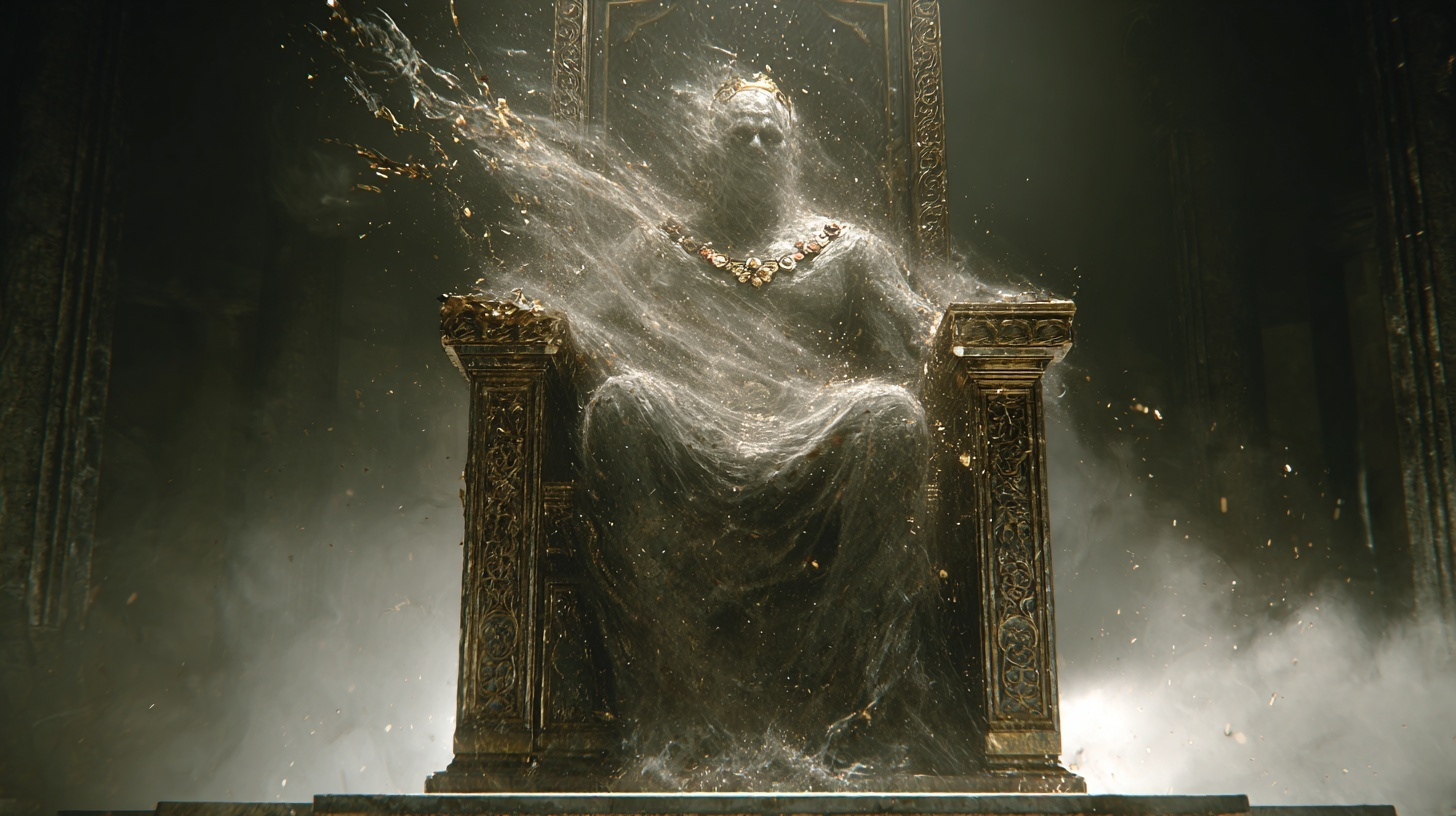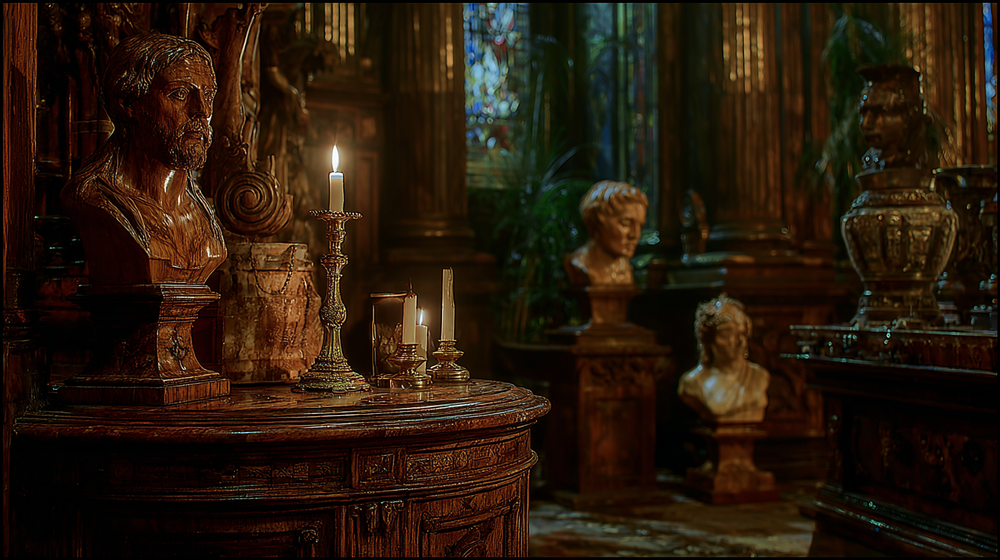Episode 2: The Hollow Senex

This is a story about a figure you already know. You have met him at work, seen him on the news, and perhaps, you have even found him in your own home.
The Parable
There was a man possessed by very rigid beliefs and held everyone to these same standards. Their failures merited swift punishment and damnation, and their successes were lauded and claimed as his own. Through all of his efforts, he knew not wisdom; however, in the light of the day, his external validations were renowned.
The Questioner: How is it that you can claim credit for success but refuse to accept your own involvement in failures? I see you wear your patches proudly. Tell me, which of those have you earned on your own? Which people helped you to achieve these ends?
The Hollow Senex: Who are you to question me? It is well known that my beliefs are accepted far and wide, and if you do not accept them, then everyone will hate you!
The Questioner: I see my questions have troubled you; that was not my intent, and for that I apologize. However, your response is curious; tell me, why will everyone hate me? I think, rather, that you will hate me, which is no less endearing.
The Hollow Senex: I will hate you, and so will everyone else. You are different, you are not one of us, and you are not welcome here.
The Questioner: I see the problem here. You can only see in black and white, while the world is known to many in a vast array of colors. Tell me, when you look in the mirror, what do you see?
The Questioner then held up a mirror, and the conversation ended.
Reflection Questions
- First… where in the world around you, in the systems you inhabit, do you see the Hollow Senex operating most clearly?
- Second… in your own personal life, in your relationships, who plays this role? Who in your life cannot be questioned?
- And finally, the most challenging question. The one we must have the courage to ask ourselves. Where is the Hollow Senex in you? When do you wear unearned patches to prove your worth? When do you blame others for a failure that is at least partly your own? What question are you most afraid to have someone ask you?
Transcript
Welcome to The (all) Unknowing. Let us hold a candle to the path and see what reflections await us in the mirrors of the mind.
In our last episode, our threshold episode, I spoke of the two great illusions of our time. Today, we will look into the mirror of the first of those illusions. This is a story about a figure you already know. You have met him at work, seen him on the news, and perhaps, you have even found him in your own home.
Have you ever had a boss who took credit for your best idea? Or a parent who blamed you for something that was clearly their mistake? We all know this figure. We carry the memory of their sting.
This figure has a name. And today, we will look into the mirror of the Hollow Senex.
This is the parable of the Hollow Senex.
There was a man who was possessed by very rigid beliefs and held everyone to these same standards. Their failures merited swift punishment and damnation, and their successes were lauded and claimed as his own. Through all of his efforts, he knew not wisdom; however, in the light of the day, his external validations were renowned.
The Questioner: How is it that you can claim credit for success but refuse to accept your own involvement in failures? I see you wear your patches proudly. Tell me, which of those have you earned on your own? Which people helped you to achieve these ends?
The Hollow Senex: Who are you to question me? It is well known that my beliefs are accepted far and wide, and if you do not accept them, then everyone will hate you!
The Questioner: I see my questions have troubled you; that was not my intent, and for that I apologize. However, your response is curious; tell me, why will everyone hate me? I think, rather, that you will hate me, which is no less endearing.
The Hollow Senex: I will hate you, and so will everyone else. You are different, you are not one of us, and you are not welcome here.
The Questioner: I see the problem here. You can only see in black and white, while the world is known to many in a vast array of colors. Tell me, when you look into the mirror, what do you see?
The Questioner then held up a mirror, and the conversation ended.
The man in this story... the one who cannot bear to look in the mirror... this is the Hollow Senex. The Tyrant King. The ghost on the throne.
The term "Senex" is Latin for "old man," and it's the root of words like "senate" and "senior." It's an archetype of the elder, the patriarch, the authority figure. But in this case, the authority is hollow.
To understand him, imagine a coach whose team wins a championship. He stands before the cameras and says, "My strategy, my leadership, I won this." But when the same team loses the next week, he tells the players, "You lost. Your mistakes cost us everything."
This is the essential dynamic. The Hollow Senex has no stable sense of self on the inside; his entire identity is outsourced. He engages in a kind of energetic vampirism—he must feed on the successes of those around him to feel valuable, and he must project his own failures onto them to avoid psychic collapse. He needs others to fail so he has someone to punish, and he needs them to succeed so he has something to consume.
But to truly understand him, we must first understand the archetype he is the shadow of. The healthy Senex is the Wise Old King. He is the good father, the tenured professor, the master craftsman. His power is real, earned through experience and wisdom. He provides stable structure, mentorship, and sound judgment. Because his strength is genuine, he is not afraid of being questioned; he welcomes it. He can admit fault, because his identity is not threatened by it. He builds a kingdom that can thrive without him.
The Hollow Senex is the shadow of this. He is the Tyrant King. The Devouring Father. He provides rigidity instead of structure, control instead of order, and dogma instead of wisdom. And the kingdom he builds is a reflection of his own inner hollowness—brittle, fearful, and obsessed with the outward performance of success.
The effect of this on any system he governs—be it a company, a country, or a family—is catastrophic. He creates a culture of fear. In a world where failure is swiftly punished and never seen as a tool for learning, genuine creativity dies. Why would anyone risk a bold new idea when the penalty for failure is exile, and the reward for success is seeing your boss take the credit? This is the architecture of stagnation. The primary goal of the organization is no longer to discover the truth or create the best product, but to engage in blame-avoidance.
This culture of fear corrodes the most vital element of any healthy system: trust. Authentic relationships cannot survive in this environment. They are replaced by transactional loyalty and performative flattery. The Hollow Senex does not want honest advisors; he wants a court of sycophants who will reflect his own greatness back to him. Communication becomes guarded, agendas become hidden, and vulnerability becomes a liability. This is how a vibrant team becomes a toxic workplace, how a political party becomes an ideological echo chamber, and how a family becomes a silent battlefield of resentment.
The key to understanding him is in his relationship with failure. The ego of the Hollow Senex is so brittle, so fragile, that it cannot withstand the slightest crack. To admit a failure, to accept responsibility, would be to admit a flaw in the entire structure. And so the structure must be protected at all costs. All failure must be projected outward. All success must be absorbed inward.
The "patches" he wears are a crucial symbol. Think of them. They are military medals, corporate awards, university degrees, job titles, the number of followers on social media. They are purely external validations. They are sewn onto the outside of the jacket because there is no sense of validation on the inside. He needs the world to tell him who he is, because he himself does not know. He knows not wisdom.
This reveals the architecture of his psychological prison. His "rigid beliefs" are not principles born of wisdom; they are rules designed for control. The rigidity isn't a sign of strength, but of extreme brittleness. He cannot afford to see the world in color, to hold paradox, because that would require him to see himself as both a success and a failure, both powerful and dependent. The black-and-white binary is his life support.
And it is crucial to understand that the Hollow Senex is not merely a personal failing. He is very often a symptom and a product of the sick systems he governs. Our corporate, political, and even academic hierarchies often reward the very skills he has perfected: political maneuvering, blame-shifting, and exploiting the work of others. He is not a failure of the system; he is a resounding success within it. He is perfectly adapted to thrive in any environment that values the performance of authority over its substance.
And because his identity is built on this fragile scaffolding of external approval, he cannot tolerate genuine questions. A question is a threat. It probes the structure. And when the structure is hollow, a probe could cause a total collapse.
So, he reacts not with an answer, but with an attack. First, he attacks the questioner's status: "Who are you to question me?" Then, he invokes the power of the collective mob: "Everyone will hate you." This is his only defense: to isolate and demonize the person who dares to look too closely.
And the only true response, the only thing that can end the conversation, is the mirror. You don't have to fight him. You don't have to argue with him. You only have to reflect him back to himself. Because the one thing the Hollow Senex cannot bear to look at is his own emptiness.
This archetype runs our world. It sits at the head of boardroom tables and in the highest offices of government. But it also sits at the head of the dinner table in many families. It's the father, or mother, who can never be wrong, whose love is conditional, whose authority must never be questioned. It's a sickness of the soul that mistakes rigidity for strength and control for wisdom.
And now, I will leave you with the questions this mirror asks of us.
First… where in the world around you, in the systems you inhabit, do you see the Hollow Senex operating most clearly?
Second… in your own personal life, in your relationships, who plays this role? Who in your life cannot be questioned?
And finally, the hardest question. The one we must have the courage to ask ourselves. Where is the Hollow Senex in you? When do you wear unearned patches to prove your worth? When do you blame others for a failure that is at least partly your own?
What question are you most afraid to have someone ask you?
Contemplate that. And we will meet again.
Go well on the path of unknowing.
A Deeper Look: A Guide to the Mirror
This parable is a multi-layered diagnostic tool. It provides a clinical psychological profile, illustrates a classic philosophical conflict, and critiques the systems that produce such figures. Below are three layers of analysis to help illuminate the reflection.
The Heart of the Story
Imagine a coach who says "WE won!" when the team wins, but "YOU lost!" when the team loses. He wears lots of medals but won't say if he earned them or if other people helped. When someone asks him about this, instead of answering, he gets mad. He yells, "How dare you question me! If you don't agree with me, everyone will hate you!"
The person asking stays calm and points out that the coach only sees in black and white. Then he holds up a mirror. The story ends there because the coach can't answer. He has never really looked at himself; he only looks at his medals and what others think of him. When you can only see in black and white, what happens when you finally have to see yourself clearly?
The Archetypal Framework
This parable is a complete psychological autopsy of patriarchal authority in collapse.
- The Architecture of False Authority: "Rigid beliefs" are the core mechanism. He doesn't have principles; he has RULES—external forms emptied of wisdom. The rigidity isn't strength but brittleness.
- The Vampiric Dynamic: "Successes...claimed as his own" shows an energetic parasitism. He NEEDS others to fail (for punishment) and succeed (for his own validation).
- The Questioner as Therapist-Warrior: Each question is surgically precise, targeting a specific defense mechanism like grandiosity and dependency. The Questioner's calm apology is masterful, exposing that mere questions cause a system failure.
- Narcissistic Rage as Revelation: "Who are you to question me?" The shift from the content of the question to the authority of the questioner exposes the hollow core. He can't defend his position, only his right to hold it.
- Black/White as Psychological Prison: The Senex cannot hold paradox. He cannot see himself as both a success AND a failure, powerful AND dependent. The binary is his life support.
- The Mirror as Inevitable End: The conversation ends because the Hollow Senex cannot survive genuine reflection. The mirror doesn't attack; it simply shows. Reality itself becomes the revolution.
The Deeper Philosophical Framework
This parable is a clinical diagnosis of an archetypal figure whose inner world has collapsed, leaving only a brittle external shell of control. He is the human face of a dying paradigm.
1. The Psychological Architecture
The Senex is a perfect representation of a personality structure trapped in what Jacques Lacan would call the Imaginary Order. He is pathologically fixated on his own image as reflected by external markers ("patches," reputation). The Questioner's calm inquiries are not a dialogue but a profound narcissistic injury, and the Senex's reaction is pure narcissistic rage—a desperate, primitive defense mechanism designed to annihilate the source of the injury.
2. The Philosophical Confrontation
The dialogue is a timeless conflict. The Questioner is a modern Socrates, using cross-examination not to defeat the Senex, but to reveal his ignorance to himself. The Senex's defense is a textbook example of Michel Foucault's concept of power-knowledge. His authority comes not from truth, but from his position within a power structure. He appeals not to evidence, but to the power of the dominant narrative.
3. The Systemic Diagnosis
The Hollow Senex is not an anomaly but a symptom and a product of pathological systems. In many corporate, political, and academic hierarchies, the skills required for advancement are not competence and wisdom, but political maneuvering, blame-shifting, and the exploitation of subordinates. The Senex is not a failure of this system; he is a resounding success within it.
4. The Mirror as Archetypal Confrontation
The final act of holding up the mirror is the parable's most potent statement. The mirror is the archetypal symbol of the Self—the integrated whole that contains both light and shadow. The Senex's entire ego-structure is a defense against the Self. His ego, built entirely on external validation, cannot survive a direct confrontation with its own totality and simply dissolves in the face of an undeniable, integrated reality. It is a non-violent annihilation through truth.
The mirror awaits your gaze.
A Final Thought...
This exploration is a reader-supported publication. It is sustained entirely by the generosity of readers like you who believe in the value of this inquiry.
If you found meaning in this piece, please consider becoming a paid supporter. Your contribution, no matter the size, makes this work possible and keeps it accessible to all.
Thank you for reading.
A One-Time Offering
If this particular mirror reflected something meaningful for you, you can make a one-time contribution here:
Author
Sign up for The (all) Unknowing newsletters.
Stay up to date with curated collection of our top stories.



